
Sir Thomas Burnett, 1st Baronet of Leys (died 27 June 1653) was a feudal baron and leading Covenanter who had represented Kincardineshire in the Scottish Parliament in 1621.

Sir Thomas Burnett, 1st Baronet of Leys (died 27 June 1653) was a feudal baron and leading Covenanter who had represented Kincardineshire in the Scottish Parliament in 1621.
The eldest surviving son of Alexander Burnett of Leys and Katherine, eldest daughter of Alexander Gordon of Lesmoir, "Thomas Burnaetus de Leyes" appears in the records of King's College, Aberdeen and Aberdeen University, as a student who matriculated in 1603. In 1604 and 1606 when he was a witness to sasines he is designed as his father's "son and heir apparent", whom he succeeded in 1619 in the feudal barony of Leys and a range of other lands and rights. He completed the work of restoring Muchalls Castle, which his father acquired in the year 1588.
In 1619, prior to his father's death, Thomas Burnet younger of Leys was one of a body of Commissioners named by King James VI of Scotland, at the instance of Bishop Patrick Forbes, to visit the universities of Aberdeen. The same year he was made an honorary Burgess of Aberdeen, and in 1620 he was knighted. He was one of the earliest recipients of the dignity of Baronet of Nova Scotia, his patent dated at Holyroodhouse on 21 April 1626.
In the Act of 1621 for the Plantation of new kirks, mention is made of Burnet of Leys having petitioned for the erection of a new church at Fetteresso, the parish in which his lands and castle of Muchalls lay, the castle being begun by his father was completed by Sir Thomas in 1627. The religious strife of the 1620s found Sir Thomas a decided opponent of the Episcopalian Court party and he became a supporter of the Solemn League and Covenant.
Immediately on the subscription of the Covenant in Edinburgh, the powerfully organized body, known as the Tables, made arrangements for enforcing its acceptance throughout the whole country and gathering funds to support military detachments.
Sir Thomas Burnett of Lees was one of their commissioners for the district north of the Grampians. He and other Commissioners paid a preliminary visit to Aberdeen in early July 1638 where they were told politely but firmly by the town's magistrates and other leading citizens that they had no legal authority to exact the subscriptions demanded. The deputation returned in force on the 20th of that month headed by the Earl of Montrose, then an earnest Covenanter, with several notable Covenanting preachers with them. The latter were promptly refused the pulpits of the city churches. The university promptly denounced the Covenant as unlawful, and three of the leading preachers, Henderson, Dickson, and Cant, made a temporary retreat to the safety of Sir Thomas's Muchalls Castle.
In March 1639, some 11000 men under Montrose and Huntly were told to 'reduce' the northern districts to subjection, but on 12 March 1639, Montrose and Argyll wrote to Sir Thomas Burnett of Leys to reassure him. Aberdeen made strong representations to Montrose who retired to Strathbogie whilst his army were admitted into the town for accommodation, most of the opposition to them having fled. Sir Thomas Burnett was one of the tribunal established to sit on 2 April in Greyfriars Church there and on following days, to force 'malignants' to subscribe to the Covenant under pain of confiscation of their goods. Viscount Aboyne's part of the Covenanting army then encamped at Muchalls and ransacked Burnett's property, despite his protestations.
Further Covenanters arrived at Aberdeen in 1644 under the Earl of Argyll and the Earl Marischal, and during that occupation a Committee of the Estates for Northern Business met there, to which a petition was presented by Lord Fraser, Sir Thomas Burnett of Leys, Patrick Leslie the Provost, and others, complaining of their losses by the quartering of troops and seeking redress from the first and readiest effects of the 'malignants' which come to hand.
Later that year, Montrose, raised to a Marquess and now opposed to the Covenant, marched north to suppress opposition to the King's cause. Leys clearly thought the Covenanters had gone too far in open rebellion against their King, and summoned Montrose to his castle at Crathes to sup with him, whereupon he offered Montrose arms, horses, and 5000 merks. Montrose accepted the arms and horses but refused the money. Sir Thomas and his son were subsequently the only known Covenanters who were protected by the Marquess. In the meantime Sir Thomas armed and organised half of his retainers to protect his lands from robber bands now all too plentiful due to the state of the north. At the same time Sir Thomas petitioned the Scottish Parliament for an exemption from excise and other heavy taxation being raised for Covenanting armies being sent to England, and for aid against marauding Highlanders.
It would appear that Sir Thomas was refused exemption for he subsequently sent his whole silver plate to Edinburgh to be melted down, by way of a loan, and also loaned money to the Marquess of Argyll.
Following the Proclamation of Charles II as King in Scotland, the Scottish Parliament adopted the most uncompromisingly covenanting character and its records for 1649 contain a complaint from Sir Thomas Burnett of Leys to the effect that he was owed £67,000 for supporting their cause. The result was an act of Parliament [ which? ] in favour of Sir Thomas exempting him from further levies and recommending he be repaid, although it is unclear he ever was.
Charles II summoned Sir Thomas to support him in a letter dictated to the Earl Marischal dated 5 October 1650. The King wrote again to Sir Thomas on 12 April 1651, granting him an exemption from the quartering of soldiers. There followed Charles's defeat at the battle of Worcester after which there were widespread persecutions. However, Sir Thomas Burnett appears to have again trod a diplomatic course as General Monck wrote to him from Dundee on 26 December 1651, assuring him of protection.
Sir Thomas Burnett had co-operated with Bishop Patrick Forbes in removing 'abuses' in King's College, Aberdeen, and amending its discipline, although there is no trace of his having had a hand in its "purgation" in 1640. His continued love of his Alma Mater, notwithstanding its prelatic leanings, is shown by his endowment, in October 1648, of three Bursaries of Philosophy in King's College. The Parliamentary records of 1649 record Sir Thomas again as one of a proposed Commission to visit Aberdeen University.
Another education foundation by Sir Thomas Burnett was an endowment by a bond of 5,000 merks to the Grammar School of Banchory-Ternan on 29 October 1651.
At a later period he built a hospital at Banchory for the support of the aged dwelling on his estates and, in October 1651, he mortified 6300 merks secured on his lands in the parish of Crimond for the inmates of that hospital.
Sir Thomas was twice married with issue from both. He married (1) Margaret (d. before August 1621), eldest daughter of Sir Robert Douglas of Glenbervie, second son of William Douglas, 9th Earl of Angus. They had two sons and two daughters,
He remarried by contract dated 9 August 1621 (2) Jean, daughter of Sir John Moncrieff of that Ilk, and widow of Sir Simon Fraser of Inverallochy. They had three sons and four daughters.
A portrait of Sir Thomas by the Scottish painter George Jameson remains in Crathes Castle.

James Graham, 1st Marquess of Montrose was a Scottish nobleman, poet, soldier and later viceroy and captain general of Scotland. Montrose initially joined the Covenanters in the Wars of the Three Kingdoms, but subsequently supported King Charles I as the English Civil War developed. From 1644 to 1646, and again in 1650, he fought in the civil war in Scotland on behalf of the King. He is referred to as the Great Montrose.

George Gordon, 2nd Marquess of Huntly, styled Earl of Enzie from 1599 to 1636, eldest son of George Gordon, 1st Marquess of Huntly by Lady Henrietta Stewart, daughter of Esmé Stewart, 1st Duke of Lennox, born at Huntly Castle, Huntly, Aberdeenshire, in Scotland was brought up in England as a Protestant, and later created Viscount Aboyne by Charles I.

Crathes Castle is a castle, built in the 16th century, near Banchory in Aberdeenshire, Scotland. It is in the historic county of Kincardineshire. This harled castle was built by the Burnetts of Leys and was owned by the family for almost 400 years. The castle and its grounds are currently owned and managed by the National Trust for Scotland and are open to the public.
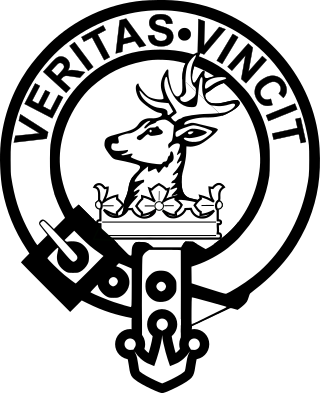
Clan Keith is a Highland and Lowland Scottish clan, whose Chief historically held the hereditary title of Marischal, then Great Marischal, then Earl Marischal of Scotland.
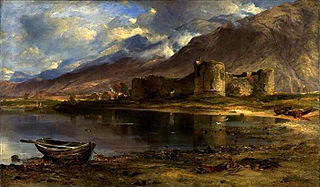
The Battle of Inverlochy occurred on 2 February 1645, during the Wars of the Three Kingdoms, when a Royalist force of Highlanders and Confederate Irish troops under the overall command of James Graham, 1st Marquess of Montrose, routed and largely destroyed the pursuing forces of Archibald Campbell, 1st Marquess of Argyll, who had been encamped under the walls of Inverlochy Castle.

William Keith, 7th Earl Marischal was a Scottish nobleman and Covenanter. He was the eldest son of William Keith, 6th Earl Marischal.

Findon or Finnan is a fishing village eight miles south of Aberdeen, famous for originating the smoked haddock known as Finnan haddie. The Findon moor has a number of paths through it, many of which run along the cliffs. Deer can often be seen there. Nearby features include the Portlethen Moss Nature Reserve.

Muchalls Castle stands overlooking the North Sea in the countryside of Kincardine and Mearns, Aberdeenshire, Scotland. The lower course is a well-preserved Romanesque, double-groined 13th-century tower house structure, built by the Frasers of Muchalls. Upon this structure, the 17th-century castle was begun by Alexander Burnett of Leys and completed by his son, Sir Thomas Burnett, 1st Baronet, in 1627. The Burnetts of Leys built the remaining four-storey present-day castle.

The House of Burnett is a Lowland and Border Scottish family composed of several branches. The Chief of the Name and Arms of Burnett is James Comyn Amherst Burnett of Leys.

Portlethen Village is a settlement located to the east of Portlethen along the North Sea coast in Aberdeenshire, Scotland. The village is also known as Old Portlethen. The skerry of Craigmaroinn is situated just off the coastline near Portlethen Village.

Downies is a cliff-top village in Aberdeenshire, Scotland situated on Cammachmore Bay. Historically Downies was a fishing village, until much of the local North Sea fishery collapsed from overfishing; presently Downies is chiefly a residential dormitory adjunct to the city of Aberdeen.
Sir Thomas Burnett of Leys, 3rd Baronet,, Lord Clerk Register, PC, MP. He was, at Stonehaven, 21 April 1664, retoured as heir to his father, Sir Alexander Burnett, 2nd Baronet who had died the previous year. The 3rd Baronet is the grandson of Sir Thomas Burnett, 1st Baronet, who completed the reconstruction of Muchalls Castle and the great-grandson of Alexander Burnett of Leys, who completed the construction of Crathes Castle.

The Bridge of Dee or Brig o Dee is a road bridge over the River Dee in Aberdeen, Scotland. The term is also used for the surrounding area of the city. Dating from 1527, the bridge crosses at what was once the City of Aberdeen's southern boundary.
The Burn of Pheppie is an easterly flowing coastal stream in Aberdeenshire, Scotland that discharges to the North Sea immediately north of the village of Muchalls. Draining chiefly agricultural lands, this stream has a notable lack of turbidity and a pH level of approximately 8.02. Armouring of the stream bottom consists of pebbles, many of which are quartzite in composition, leading to a golden-green effect in some locations. Other nearby watercourses discharging to the North Sea include Burn of Elsick to the north and Burn of Muchalls to the south.
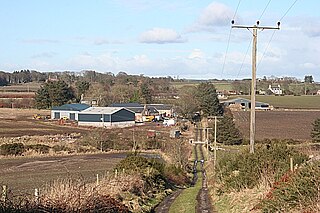
The Causey Mounth is an ancient drovers' road over the coastal fringe of the Grampian Mountains in Aberdeenshire, Scotland. This route was developed as the main highway between Stonehaven and Aberdeen around the 12th century AD and it continued to function as the principal route connecting these two cities until the mid 20th century, when modern highway construction of the A90 road occurred in this area. There are extant paved and usable sections of this road over part of the alignment; however, many parts of the ancient route are no more than footpaths, and in some cases the road has vanished into agricultural fields. Constructed in the Middle Ages, the Causey Mounth was created as an elevated rock causeway to span many of the boggy areas such as the Portlethen Moss. A considerable portion of the alignment of the Causey Mounth is illustrated on the UK Ordnance Survey Map, although a large fraction of the route cannot be navigated by a conventional passenger vehicle.
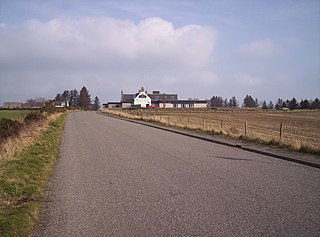
Cammachmore is a hamlet in the coastal region near the North Sea in Aberdeenshire. It lies slightly west of the A92 road and the ancient Causey Mounth passes through the community. Historic Elsick House is situated due west of Cammachmore. Other nearby historic features include Gillybrands, Saint Ternan's Church, Muchalls Castle and the Lairhillock Inn.
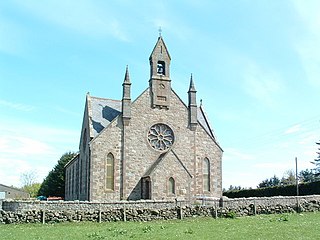
Cookney is a hamlet in Aberdeenshire, Scotland in proximity to Netherley in the Mounth of the Grampian Highlands. The community is situated on a hilltop approximately 5 miles (8 km) northwest of Stonehaven, about 3 miles (5 km) northwest of the Bridge of Muchalls, and about 2 miles (3 km) west of Muchalls Castle. From Cookney a portion of the ancient route of the Causey Mounth is visible to the east near Whinward Farm, although the track is not truly recognizable from that distance. The Cookney Church is a prominent historic landmark of Cookney.

Banchory-Devenick is a hamlet approximately two kilometres south of the city of Aberdeen, Scotland in the Lower Deeside area of Aberdeenshire. The hamlet should not be confused with the historic civil parish of the same name which spanned the River Dee until 1891, its northern part lying in Aberdeenshire and its southern part in Kincardineshire. In that year the northern part became part of the neighbouring parish of Peterculter, the southern part remaining as the parish of Banchory-Devenick. The hamlet of Banchory-Devenick is on the B9077 road, and the ancient Causey Mounth passes directly through it. An historic graveyard dating to 1157 AD is present within Banchory-Devenick. Other historic features in the vicinity include Saint Ternan's Church, Muchalls Castle and the Lairhillock Inn.

Cookney Parish Church, now business premises within a converted listed building, was a Christian place of worship in the village of Cookney, Aberdeenshire, Scotland.
Hare Moss is a bog in Aberdeenshire, Scotland, in the vicinity of Banchory-Devenick. Hare Moss is a significant wetland ecosystem.